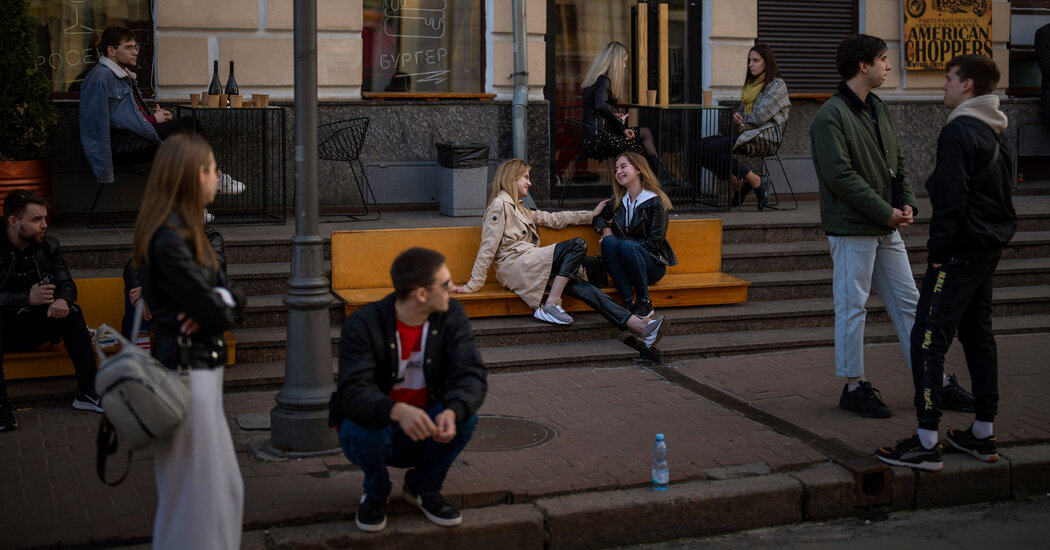It had been a sound missing from Ukraine’s capital for months. Then, on a balmy spring afternoon, the chatter of children’s voices again filled a playground.
In a park beside the sky-blue cathedral of St. Michael’s Golden-Domed Monastery, in central Kyiv, a few young children clambered over a jungle gym and rocked on a seesaw.
Mothers stood idly by, chatting. The scene captured the mood of Kyiv these days, as tension slowly seeps out of a city that for weeks had been in the grips of an almost unimaginable, electric state of alarm.
In the early days of the war, families fled. The thud of artillery echoed through the streets. Countless sandbag checkpoints went up. And looming over the city was the prospect of fighting in the streets or a drawn-out siege.
Now, a month after the Ukrainian Army defeated the Russian forces that had partly encircled Kyiv, the city is enjoying a return to something like normalcy.
For most of April, more residents returned to the capital than left, though the mayor has recommended that most families refrain from returning while threats from the ongoing war linger.
The prewar population of the metropolitan area of Kyiv was about four million; it dropped by half over a few hectic days in February. Despite some families returning, many people with children remain in western Ukraine or as refugees in Europe, facing an uncertain future.
Back in March, Honey Café, a cozy bakery and coffee shop on Yaroslaviv Val Street that for unclear reasons reopened for business quickly, seemed the only spot in town to sit down for coffee. Even so, waiters warned, “Don’t sit near the windows,” lest an explosion spray glass shards.
Today, sidewalk cafes are popping up throughout Kyiv. Some restaurants are packed again, the once usual, if unwelcome, state of affairs. At Tin Tin Food Spot, a restaurant beside the city’s bicycle racing track, a lunchtime crowd filled every seat on Sunday afternoon.
The mood of the residents is one of deep gratefulness: that the city is still standing, that life can resume. It has made for a general sense of bonhomie.
On a recent hourslong walk, meandering through the cobblestone back streets of the Golden Gate and Podil neighborhoods, passers-by smiled or nodded pleasantly.
The chestnut trees were in bloom. And from time to time, on the crests of hills, the city’s still-intact skyline of golden church cupolas and high-rise buildings came into view.
To be sure, the war is still raging in eastern Ukraine. like Mariupol and Kharkiv are shelled daily. And few in Kyiv discount another attempt on the capital, should the Russian Army muster the strength. Tens of thousands of residents of Kyiv have relatives in combat in the east who are in grave danger.
Russia-Ukraine War: Key DevelopmentsCard 1 of 4
Fears of an expanded war rise. With the Russian military still struggling, Western officials are looking with increased alarm to Russia’s Victory Day holiday on May 9. Anxiety is growing that President Vladimir V. Putin will exploit the celebration of the Soviet triumph over the Nazis to intensify attacks and formally declare war.
Russian oil embargo. The European Union unveiled a plan to halt imports of Russian crude oil in the next six months and refined oil products by the end of the year. If approved as expected, it would be the bloc’s biggest and costliest step yet toward ending its own dependence on Russian fossil fuels.
Support for Moldova. The E.U. promised to proe additional military support for Moldova, the increasingly pressured neighbor of Ukraine. Security fears have grown there during the invasion, swelling after a series of explosions rocked Transnistria, the country’s own breakaway region, where Russia has maintained soldiers since 1992.
On the ground. Moscow continued to demonstrate its destructive power. In the western city of Lviv, strikes on three power substations knocked out electricity in many areas. In the eastern region of Donetsk, 21 people died on May 3, the highest number of casualties in a day since last month.
The vicious street fighting and widespread human rights abuses by the Russian Army in Kyiv’s suburban towns, including Irpin and Bucha, left residents traumatized and most likely facing months or years of emotional adjustment before any sense of safety returns, officials and aid workers have said.
And countless families have been separated as they have been forced to flee their homes, either as internally displaced people or as refugees to other countries in Europe.
Russian cruise missiles, fired from hundreds of miles away, still target the capital from time to time, striking military sites and residential buildings. But they are isolated strikes, for now posing little general risk to residents.
And so, after weeks of upheaval and clenched nerves, Kyiv has become a city where, at the least, just one ordinary spring day can again be enjoyed as a small blessing.



